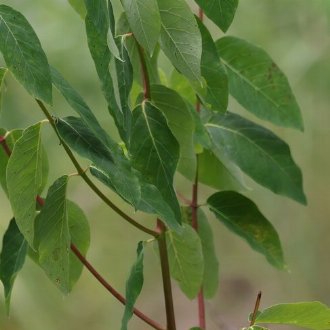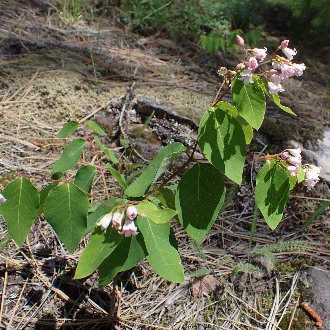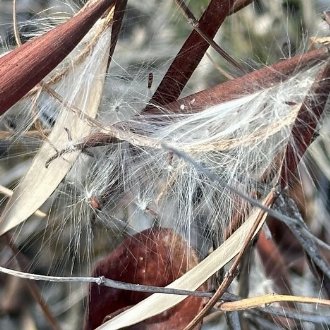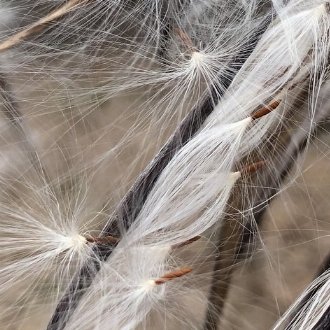Spreading Dogbane vs Hemp Dogbane
These two species are visually similar and have a large range of overlap, although their habitats overlap little. They are easily distinguished by their blooms, or in winter by seed length, and they also have differences in growth habit. A. androsaemifolium prefers drier, shadier conditions, and acidic, sandy or rocky soil, whereas A. cannabinum is found in sunnier, wetter habitats that only become dry later in summer, with richer, loamy to clayey soil, or on calcareous rocks, and ranges farther south in the eastern and central portions of its range. These species can and do hybridize in much of their range, producing intermediate dogbane (Apocynum ×floribundum), which is uncommon and harder to identify.
Spreading Dogbane (Apocynum androsaemifolium) | Hemp Dogbane (Apocynum cannabinum) |
A rhizomatous perennial of dry, barren, partly-shaded areas. | A rhizomatous perennial of moist, disturbed, sunny areas, native across North America. |
Flowers are larger (6-10mm long) and either pink, or white with pink stripes. Petals curve back at the tips. Many of the flowers in each cluster are drooping. Photo © Alina Martin, CC BY 4.0. | Flowers are shorter (3-6mm long) and range from bright white to greenish or yellowish. Petal tips do not curve back. Flower clusters are more globe-shaped and flowers are not usually drooping. Photo © geosesarma, CC BY 4.0. |
Leaves are often angled downward, even when plant is not wilted from drought stress. Photo © Lauren McLaurin, CC BY 4.0. | Leaves are usually angled horizontally or even upward, and do not usually droop unless plants are very drought-stressed. Photo © Sandy Wolkenberg, CC BY 4.0. |
Found in drier, partly shaded, more barren habitats with rocky or sandy soil where there is less competition from other plants. Photo © Aiva Noringseth, CC BY 4.0. | Found in moister, richer, sunnier habitats where soil is better at retaining water and there is often more competition from other plants. Photo © Lexi Destria, CC BY 4.0. |
Plants are usually shorter (under 80cm or about 2.5 ft) and branches are more horizontal, often drooping at their tips. Photo © Aiva Noringseth, CC BY 4.0. | Plants usually grow taller (to 1.5m or nearly 5 ft) and branches are more consistently angled upwards. Photo © Treeguy, CC BY 4.0. |
Seeds are much smaller (1.5-2mm long) Photo © kallummcdonald, Public Domain. | Seeds are much larger (3-6mm long) Photo © jonsense, CC BY 4.0. |
Additional Notes
The differences in growth habit between these species correspond to differences in habitat: in the drier, shadier habitats preferred by A. androsaemifolium, there is little competition from ground-level vegetation and as such plants do not need to grow upright to reach light, but benefit from being lower to the ground where wind speeds are lower, so as to reduce drought stress. On the other hand, in the moister, sunnier habitats preferred by A. cannabinum, there is more competing vegetation and thus plants need to grow taller and branches and leaves often need to grow upwards to reach light, and there is less cost to doing so because plants are subjected to less drought stress, both due to the moister conditions, and also due to surrounding vegetation reducing wind speeds.The difference in seed size is also related to habitat; A. cannabinum needs larger seeds to push up through competition to reach light, whereas the tiny seeds of A. androsaemifolium are sufficient for establishing in the barren habitats where it occurs.
References & External Resources
These short lists show only links helpful for ID. For a complete list of references and resources also covering other aspects of ecology, visit the links section of the full article on each plant, which is the first entry here.












